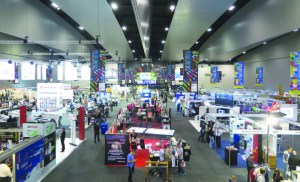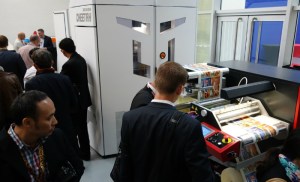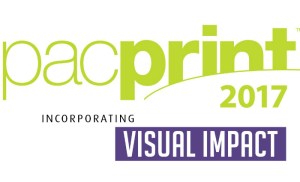
Key trend #1
Humanless print production
The first and most intriguing revelation was the prospect of automation being taken to its ultimate degree, with the elimination of people from the print production process. Heidelberg told us it was aiming to have its presses as self-managing print manufacturing units.What it means by this is no printers involved. It already has the means to load and unload paper automatically and presumably it is looking at some sort of cassette system for the plates, or is maybe thinking of the time when plates become redundant. It did launch its first inkjet press, the Primefire 106 of which more later, and an inking system like the big webs have.
But as well as no print staff, it is also working to having the press organise its own servicing; tell a service centre what needs doing and when; organise its own production schedule according upcoming jobs in the digital job file, based on delivery schedule, paper stocks and the like; and organise its own consumables – paper and inks – again based on what jobs are coming up.
Then Fuijfilm told us it has developed a lights out book production manufacturing plant, based on its Jetpress 540W digital web press allied with digitally controlled finishing equipment, all in a factory controlled by a non-linear automated robotic system from a US developer Epac.
Fujifilm says it means that the entire printing process, when using its Jetpress digital print systems, can run with no humans involved, the software and the robots taking care of the production. Initially it will be developed for short run book printing, although it is not a big step to move to producing the multiple different product types typically produced in a print plant. According to the company, an entire new book, printed and bound, and with variable data if required, will be produced every six seconds in the automated plant. Fujifilm says the lights out factory will deliver unparalleled efficiencies, and will produce unmatched quality of print, with zero waste.
Fujifilm did not go into details on the finishing but at drupa we saw new systems. For instance, the Muller Martini Infinitrim which can produce books of infinitely variable trimmed sizes automatically with barcodes on the book block telling the Infinitrim which size to trim to.
So is it saynora to humans? Well it is now on the horizon. How far out that horizon is, and whether we will ever reach it is a big question.
Key Trend #2
Prepress Collaboration
Prepress played a huge role at this year’s drupa as suppliers to the industry and their customers continued their drive toward increased automation and efficiency. From faster, more accurate and sustainable platemaking to digital front ends (DFE) and colour management enhancements, no-one should have left the show without a number of new ideas about how to streamline operations in the workflow that leads up to the pressroom.
The trend of note here – and in fact, across almost all disciplines – was the increase in collaboration among vendors, even those who are or have been competitors.
It signifies a recognition that single-vendor operations are a thing of the past, and no one vendor can provide everything that is needed in a modern printing operation. To the extent they collaborate with each other, the more they each will have a satisfied customer base. EFI and Esko, Landa and Kodak Prinergy, Konica Minollta with Tharstern MIS and Vpress W2P, all examples.
Then there was the development of app stores, hosted by a developer, and open to third parties, which the developers hope will enable users to optimise their solutions and open up new opportunities.
So HP launched PrintOS which it describes as a business operating system. With PrintOS, HP envisions an integrated, multi-vendor environment through a cloud-based operating system that changes the way operations manage print production. At drupa, HP announced that more than 500 presses at over 300 customer sites are now connected to PrintOS. The vision is to continue to add HP and third-party apps to the PrintOS app store, making implementation modular and convenient.
And Enfocus Switch which is an important solution for workflow integration, often overlooked and under appreciated, has a significant base of Switch configurators and pre-designed workflows available, but Enfocus is taking that to the next level with its own Appstore, where users can access applications that have been developed for the Switch community. Enfocus reports dozens of interested app creators and more apps introduced daily.
Key Trend #3
Cloud computing
The cloud was everywhere, (with real rain for the first week). Increasingly, printers are becoming more comfortable with a cloud-based business model, and suppliers to the industry are rallying with a plethora of cloud-based offerings. Cloud-based solutions were dominant in the drupa Innovation Parc (dip) where many smaller companies have the opportunity to affordably show their wares and take part in this important show.
Cloud is a huge win for printers, particularly the SMEs. It means they need minimal IT infrastructure, they do not need an IT specialist, they never need to buy upgrades, and there are never any compatibility issues, as everyone is always working for the same version. And it is also easier on the pocket as it is a monthly fee rather than an upfront cost. It is also bi-directional by passing your own company, so for instance on a press it will automatically communicate with the developer.
Key Trend # 4
Inkjet
Inkjet printing systems were front and centre of drupa, both webfed and sheetfed. The benefits of inkjet are those associated with digital, of no makeready and variable data, but with high speed, and sheet sizes that are difficult with cutsheet toner systems.
Actually the term inkjet is a bit of a misnomer, as it is now being used in a generic sense to include virtually all types of non-toner digital printing. This includes the liquid toner used by HP on its Indigo presses – housed on the biggest stand on the show, dwarfing all others at 6200sqm – including all its new presses.
The HP stand was packed from start to finish as HP showed a raft of innovation for a multitude of applications, ranging from commercial print, packaging, to home décor. HP is investing humungous amounts of cash into commercial printing solutions under its Indigo brand, which is great news for printers, not only in the solutions it is developing but also as a vote of confidence in the future of print.
Liquid toner is also the technology that Xeikon is using on its new Trillium inkjet web-fed press range, and by Ryobi MHI (RMGT) on its B2 digital sheetfed press DP7, that it claims will run three times faster than anyone else’s at 8000sph, and on any stock.
Slated for release some time next year the B2 sized DP7 has Miyakoshi print heads, and that speed takes it into offset territory, whereas most of the B2 inkjet presses are running around the 3000sph marker.
Even the toner king Xerox is now into inkjet printing, with a B3 cutsheet printer the Brenva and a webfed printer the Trivor. Both come from the technology that Xerox got when it acquired the French Impika inkjet company. Xerox says B2 sheetfed is next on the horizon.
Toner rival Canon is also in B3 cutsheet with its i300 printer, and showed a four-colour B2 inkjet printer the Voyager, which it says prints photo quality, it is a re-engineering of its Dream Labo photor printer.
Ricoh already has inkjet with its high volume webfed printers, and at drupa launched its VC60000 which it says will print for the commercial market. Konica Minolta has launched its B2 sheetfed inkjet AccuriJet KM-1, which is branded by Komori as the Impremia 29. Konica Minolta also showed a B1 digital folding carton press, a huge piece of kit, which it hopes to have available in the next couple of years.
Landa was a focal point at the show. Four years ago, he introduced digital inkjet nano technology which promised offset quality at offset speeds on offset stocks but with the digital benefits of no makeready and no plates. So what did we see this time four years later. There has been progress; the presses were printing and sheets were available. However, the prints are not yet commercial quality. They had no lines, edges or text, and tended to be impressionist style images with little definition, and mainly oranges, greens and browns. But Landa did have proofs produced in his lab which were at a commercial level. Can he bridge the gap? We will have to wait and see. The first presses are slated to go into beta testing in 12-18 months’ time.
Landa was doing demonstrations of the presses, in a range that has been slimmed down to four, a B1 sheetfed for folding carton, a B1 duplex (prints both sides) sheetfed for commercial printing, a webfed for publication printing and a webfed for flexo printing.
Komori which is selling the Landa S10 as the Komori Impremia S40 has halved the top speed to 6,500 in a bid to ensure quality.
So will he do it? That is the big question that went unanswered at drupa. Landa was nothing but confident though, and racked up some major orders, although they can more properly be called options to buy should the press become available, including four in Australasia – Blue Star, trade printer Hero Print, online printer Vistaprint, and an un-named flexo printer, who will join CMYKhub which ordered one last time around.
Key Trend #5
What does the rise of inkjet mean for offset presses
There were no new offset presses launched at drupa, and no A3 presses on show at all.
The A3 press market has been destroyed by digital presses from the likes of Fuji Xerox, Canon, Konica and Ricoh, and it is easy to see why, when instead of buying a four colour offset press, platemaking equipment and finishing kit in an investment of well over $1m and then manning it with expensive staff, a printer could spend little over $100,000 and have a digital printer with no makeready and online finishing that can be operated by one unskilled person.
The big question: will this happen to the B2 and B1 commercial markets? The answer has to be no, well not for the moment at least. Partly because the B2 inkjet presses are not a tenth the price of offset presses, and partly because the quality and consistency of offset print is a high benchmark. However in the years to come, that will change. In fact, the B2 Indigo presses from HP are widely acknowledged to have reached that level. I have already mentioned the B2 Ryobi, and the Landa presses if he gets it right may have a huge impact.
While they had no new presses, the offset manufacturers are making tremendous strides in productivity, with a host of inline features and ultra-quick makeready, the Heidelberg XL for instance was printing three jobs in just eight minutes.
Key Trend #6
Hybrid presses
Leading on from this is the rise of hybrid presses, which saw almost all the major offset press manufacturers partner up with inkjet developers to launch presses, and particularly in folding carton inkjet printing. Apparently there is a $400bn short run folding carton market out there, and this drupa saw a rush of vendors pile into this market. It also has to be said its a market where the quality standards are perhaps not so exacting as commercial print, if you think about the difference between a box on a supermarket shelf compared with Vogue magazine.
These hybrid presses included Heidelberg with its Primefire 106, co-developed with Fujifilm, which is the first B1 inkjet press available, the B1 Landa S10 co-developed with Komori, the Screen BHS inkjet corrugators, the KBA Xerox VariJet 106, Komori with the Impremia S40 co-developed with Landa, Ryobi with its DP7 co-developed with Miyakoshi. Screen has teamed up with BHS, the world’s biggest corrugated machinery manufacturer, and together they are developing a digital corrugated press. These partnerships make sense, the machinery guys have the paper feed, transport and delivery systems down to a tee, while the inkjet guys know how to put a billion drops of ink onto paper. Folding carton printing was not restricted to hybrid presses though, EFI launched a massive Nozomi at 100 foot long pumping out 75 metres a minute B1 sheetfed carton, Konica Minolta showed a similar sized press B1 sheetfed for folding carton, meanwhile Bobst said it was in front of everyone with two B1 inkjet sheetfed folding carton presses already in beta testing in Germany and Switzerland. Durst was a surprise entrant into digital folding carton with its B1 digital press the Rho 130 SPC with a print speed of up to 9350sqm per hour.
Key Trend #7
Digital Finishing
Finally finishing, for so long the Cinderella of the production process, but no more thanks to innovation and digitalisation. The Muller Martini Infinitrim can produce an infinite variety of book sizes with no slowdown in production for makeready, and the company’s CEO told us that makeready on finishing systems that was taking an hour 20 years ago and five minutes four years ago is now taking half a second. Companies such as Scodix and MGI are pioneering new enhancement and embellishing techniques that allow short runs, and others such as Highcon and Xeikon are developing new die cutting solutions. These names are new, bit older established developers are launching innovations too, there was a new die cutting system from Polar, which uses a laser to cut the board, then a robot to stack them.
Touching the future?
So drupa 2016, automated printing, cloud computing, inkjet printing, offset developments, was it the most important ever, we can’t say, but we can certainly say it gave a clear indication of the future of print.

Visual Impact Exhibitions, combined with Image Expo, hosts the Visual Impact shows to highlight the latest technologies, trends, and solutions in the visual graphics industries. This includes signage, digital printing, engraving, routing, awards, vinyl application, design, airbrush, screen printing, and display solutions

For over 20 years, Foodtech Packtech has run as New Zealand’s largest food manufacturing, packaging and processing technology trade show. Co-located in 2016 with the Materials Handling & Logistics Expo, the event will attract over 250 local and international exhibiting companies and some 4,500 visitors.
Pride In Print delivers tangible rewards in the commercial marketplace







